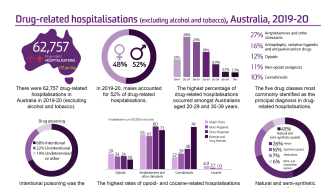172 drug-related hospitalisations per day in Australia in 2019-20
There were 62,757 drug-related hospitalisations (172 per day) among Australians in 2019-20, equivalent to 0.56 per cent of all hospitalisations in Australia, a new report has found.
There were 62,757 drug-related hospitalisations (172 per day) among Australians in 2019-20, equivalent to 0.56 per cent of all hospitalisations in Australia, a new report has found.

Led by the Drug Trends Team at the National Drug and Alcohol Research Centre (NDARC), UNSW Sydney, it was found that the largest proportion of drug-related hospitalisations in 2019-20 was attributable to amphetamines and other stimulants (27 per cent), followed by antiepileptic, sedative-hypnotic and antiparkinsonism drugs (e.g., benzodiazepines; 16 per cent), opioids (12 per cent), non-opioid analgesics (e.g., paracetamol, 11 per cent), and cannabinoids (10 per cent).
Acting Lead for the Drug Trends Program, Dr Rachel Sutherland, said, “Since 2014-15, the rate of hospitalisations for amphetamines and other stimulants (excluding cocaine) has surpassed the rate observed for opioids, and in 2019-20 it reached its highest level (70 hospitalisations per 100,000 people).”
Drug poisoning (‘overdose’) accounted for 46 per cent of drug-related hospitalisations in 2019-20; 68 per cent of these hospitalisations were deemed intentional poisoning.
Although the majority of drug-related hospitalisations in 2019-20 were among people residing in major cities (73% of hospitalisations where remoteness was coded), the age-standardised rate of drug-related hospitalisations was highest in remote and very remote areas of Australia, followed by outer regional areas; the lowest rate was observed in major cities.
“These findings highlight the importance of ensuring access to harm reduction and treatment services in remote and regional areas,” said Dr Sutherland.
Major cities had the highest rate of opioid-related (29 per 100,000 people) and cocaine-related (6.0 per 100,000 people) hospitalisations compared to other remoteness areas.
“Outer regional areas had the highest rate of hospitalisations related to amphetamines and other stimulants (80 hospitalisations per 100,000 people) and remote and very remote areas had the highest rate of cannabinoid-related hospitalisations (79 per 100,000 people),” said Dr Sutherland.
From 2018-19 to 2019-20, the rate of drug-related hospitalisations increased in the Australian Capital Territory, the Northern Territory, Queensland, South Australia, and Western Australia, decreased in Tasmania and Victoria, and remained similar in New South Wales.
Males accounted for 52 per cent of drug-related hospitalisations in 2019-20.
“This is a reversal of findings up until 2014-15 where drug-related hospitalisations more commonly involved females than males,” said Dr Sutherland.
The highest rates of drug-related hospitalisations continued to be observed among the 20-29 and the 30-39 age groups. To read the full report, go here.
Media contacts:
Katie Moses: P: 0425 287 275| k.moses@unsw.edu.au
For reference: When reporting on drug and alcohol issues, we encourage the consultation of the Mindframe guidelines on ‘Communicating about alcohol and other drugs’, the ‘Language Matters’ guide published by the NSW Users and AIDS Association, and the guidelines on “Communicating about suicide”.
People can access free and confidential advice about alcohol and other drugs by calling the National Alcohol and Other Drug Hotline - 1800 250 015.